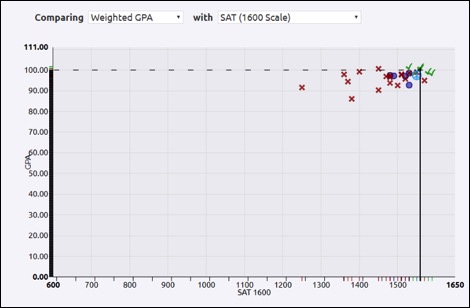You’ve researched colleges, visited campuses, and fallen in love with your dream school. Now comes the anxiety – “What are my chances?” you ask yourself. If your high school uses Naviance, the popular college admissions software, you’re one of millions of students (and their parents) in the U.S. and at independent schools worldwide, who seek to decode Naviance’s admissions scattergrams for the answer to that question.
Not familiar with admissions scattergrams? With a few keystrokes, you can pull up a wealth of information on the admissions outcomes of previous classes of students from a high school. The software plots SAT or ACT scores on the x-axis and high school GPA on the y-axis, specific to applicants to a particular college or university. Each student who applied to the college is represented by a color-coded symbol on the scattergram: green means accepted (either early or regular), red means denied admission (early or regular), and purple is purgatory (the waitlist). As a prospective applicant, you are represented by a blue symbol – right at the intersection of your GPA and your SAT or ACT.
So, will Naviance tell you if you’ll get in? The answer depends on lots of factors, so let’s decode with a few examples.
NAVIANCE: STUDENT 1, UC DAVIS
Student 1 attends a large, suburban public high school in California that utilizes a weighted 4.0 GPA and she’s trying to assess the likelihood of admission to UC Davis. Her high school has historically sent many applicants to UC Davis and, students whose SATs are greater than 1400 and weighted GPA is greater than a 3.80 have a pretty high likelihood of admission (but a few do land in purgatory).

Should this student apply to UC Davis? She should certainly have it on her list as the odds of admission are very good.
NAVIANCE: STUDENT 2, DUKE
Student 2 attends a medium-sized public high school on Long Island that uses a 100pt grading scale and he wants to apply to Duke in the early decision round. Does it make sense for him to apply early to Duke?

This one gets more complicated. He’s close – at least as measured by GPA and SAT – but zooming into the scattergram, you can see that all the students admitted to Duke from his high school slightly outperformed him in terms of GPA and SAT scores. Remember that Naviance does not factor in scores from subject tests or AP exams, and so there’s no way to gauge the impact of the student’s full testing record on the admissions outcome in this scattergram. In this case, Naviance will not help quell the anxiety of whether he’ll be admitted. But, if Duke is indeed this student’s top choice, then an early application to Duke is certainly not an unrealistic one, based solely on consideration of GPA and SAT.
NAVIANCE: STUDENT 3, PRINCETON
Student 3 attends a top boarding school on the East Coast. Her school grades on a 6-point scale and draws high-achieving students from around the country and around the world. The high school is very successful in terms of college admissions and many students get into the very top colleges. As she looks at her school’s scattergram for Princeton, she wonders about her chances of admission, since she sees several students admitted whose GPA and ACT scores are lower than hers.

In this instance, this student is unlikely to be competitive at a school like Princeton unless she has an admissions hook. It’s a fairly safe bet that the students admitted to Princeton from this boarding school whose GPAs and ACTs were lower than hers may have been recruited athletes, legacy applicants, development prospects, members of underrepresented minority groups, or students with a unique talent or perspective.
Naviance scattergrams can be useful tools in building a college list – if used thoughtfully and in consideration of all the factors that go into the admissions process.
Remember:
- Scattergrams do NOT list SAT subject tests (not always required but still VERY helpful at all top colleges) or AP tests.
- A higher unweighted GPA doesn’t necessarily mean you’ll be more competitive at top schools if your curriculum lacks rigor.
- Scattergrams for colleges and universities that are less selective will provide you with a greater degree of confidence in your admissions outcome.
- Scattergrams for the most highly selective colleges and universities will tell you if you are a reasonable applicant, but should not be seen as the final word. These schools also consider essays, extracurricular activities, recommendations, etc. – so grades and scores alone are not determinative. Additionally, students with hooks who apply to top colleges and universities will often have better outcomes than unhooked ones, even if their grades and scores are lower.
NAVIANCE: THE BOTTOM LINE
In addition to Naviance scattergrams, we encourage students to review ‘class profiles’ for their target colleges. These profiles, compiled by the colleges, provide key statistical information on past cohorts of admitted students and help you see if your scores and GPA fall in range of their average scores or GPAs (most often colleges will list the ‘middle 50% range’). And remember if you aren’t a hooked applicant, you’ll likely need to be ABOVE the posted middle 50% range for test scores and GPA.
Though predictive in nature, Naviance scattergrams are not fool proof but are a useful tool in helping to determine admissions odds. We use them all the time at Application Boot Camp and in our Private Counseling Program. As always, in the admissions process, DATA SPEAKS – so now, it’s your time to listen.
- Application Boot Camp®: Celebrating 20 Years of Success - April 25, 2024
- Get to Know College Admissions Expert, Bryan Tomlinson - April 24, 2024
- Breaking News: Cornell Reinstates Standardized Testing - April 23, 2024



2 replies on “Navigating Naviance”
How do to you get to the scattergram?
I’ve scoured Naviance, but nothing.
Hi Julie,
Sounds like you’ll need to connect with your guidance office at your school. Good luck!